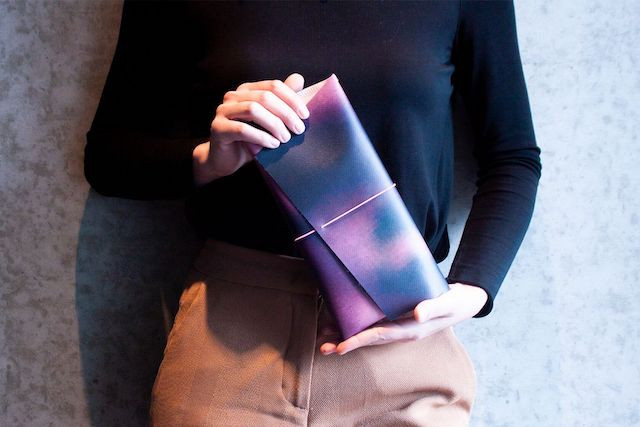The collab, titled Casino (Un)folded, is one the contemporary art forum approached her with, given they had a wide range of the tarp banners from as far back as even the 1980s. Conrad, part of a team of three at her design studio, helped come up with what she calls a “puzzle system” in which the shapes vary but they can be put into different sizes of pouches.
So far, the designer has made around 80 of them herself, using 5 of the tarps, available for sale at Casino. The 5 tarps were selected mainly because of the content. “Of course, there’s a lot of nostalgia. Some were bought by the staff,” Conrad says. “For me, it was funny as well that one of the first banners was for an exhibition [“Sous les ponts”] my friends worked on when I was 15.”
For those who want to add even more of a personal touch, at least two more workshops will be held on 11 and 18 July so participants can create their own pouches similar to how they are made at the designer’s studio.
Pieces of a puzzle
During the workshops, participants are guided through the process of tracing the shapes, cutting the pieces by hand, assembling them using a special folding technique and sewing them into place, using a sewing machine or a Japanese bookbinding technique which, Conrad says, “takes longer, but makes it more handmade”.
Conrad says she did her best to waste as little of the tarp as possible in the design, meaning the cutting starts at one end of the banner and can’t occur just anywhere, even if participants really like a particular part of the banner. She says at first this surprised some participants, but they have to arrange the “puzzle a bit…without being out of the system. It’s always interesting if you have some constraints.”

As part of the design, a programmed pen, similar to a robotic arm, is used to "stamp" the bags with banner details. Photo: JCDS
Case in point: there was a particular banner with a face and two participants wanted eyes to show on their bags. Once they worked out their puzzling together, “they got their eyes--but one was on the inside [of the bag], and one on the outside”.
A designer’s responsibility
In 2010, Conrad was an intern at a Philadelphia-based studio specialised in sustainable design which was proud to label itself as such. But when she was studying in France, she said the approach there was not to use the label of “sustainable designer… because you should just be doing that, thinking about how products are made and being discarded”. But, she adds, “I like the American approach better.”

“With design nowadays, you have to take everything into account," says Julie Conrad. Photo: Paolo Lobo/JCDS
Conrad is no stranger to sustainable design, having also designed bags using the bandage-like tarpaulin that covered Pont Adolphe some 5 years ago, working with a team of people with disabilities through Cooperation Wiltz to do so.
“With design nowadays, you have to take everything into account, to make people understand,” she says. “You also need to help educate people in a way. As a designer you decide what is on the market so people will want to buy things, but you’re also responsible for the communication around it.”
To learn more about the upcoming workshops, visit the Casino Luxembourg’s agenda.
